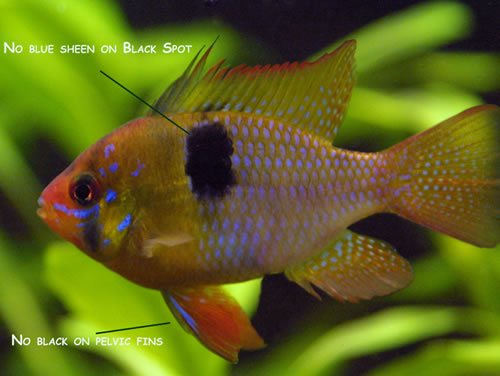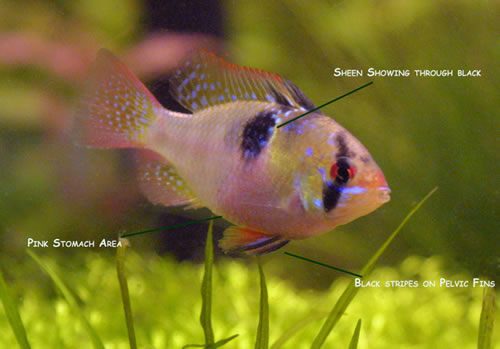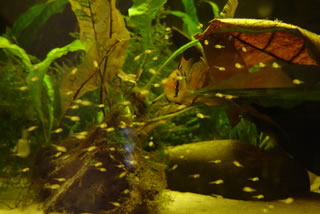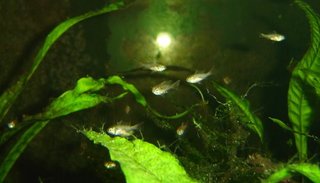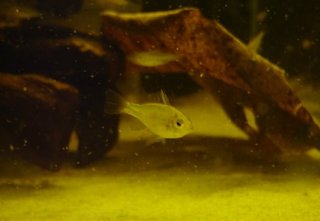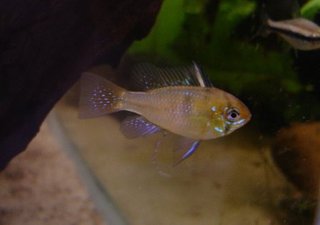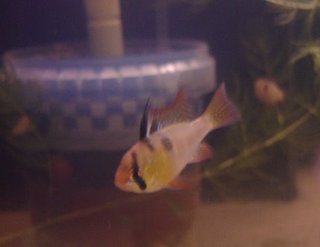German blue ram
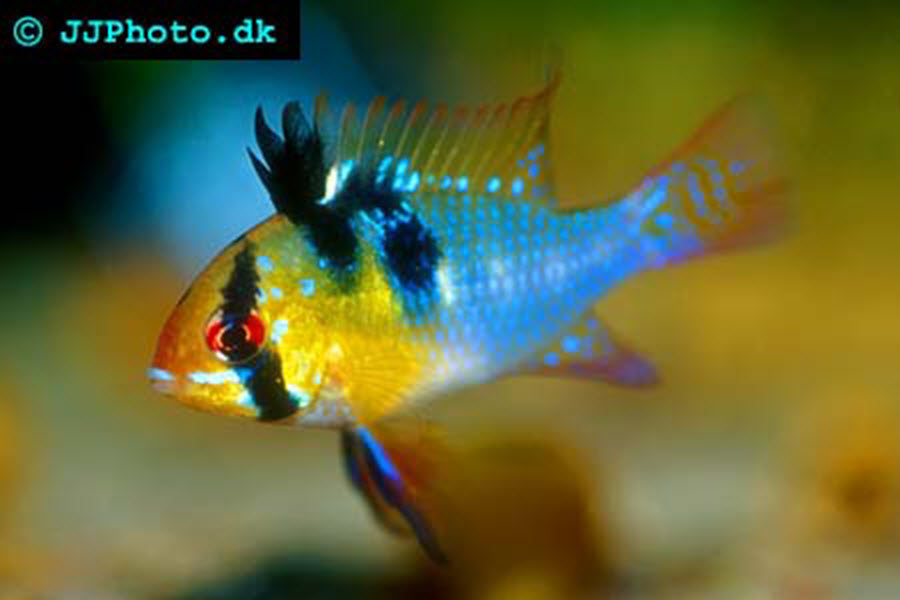
Care sheet
Mikrogeophagus ramirezi
Difficulty: IntermediateMax Size: 2-3 inch / 5-7.5 cm inches / cm
Environment: Freshwater
Biotope: Blackwater
pH: 5.0 to 7.0
Hardness: Very soft - soft
Temp: 78-85 ºF / 25.5-29.5 ºC °f / °C
Community friendly: Friendly communities
Plant friendly: Yes
Aquarium size: 20 gallons
Diseases: Prone to ich and bloat
Reproduction: Substrate Spawner
Difficulty breeding: Easy
Behaviour and Compatibility
The German ram is a small and relatively friendly species. They can be somewhat territorial. They can be kept with other small, friendly and calm fish species. Never keep with aggressive species. They prefer a planted tank
German Blue Ram information
German Blue Ram
Introduction
The German blue ram is a colorful and fairly peaceful dwarf cichlid. It is a popular aquarium fish, but is not recommended for beginners.
The scientific name of the German blue ram is Mikrogeophagus ramirezi. It belongs to the subfamily Geophaginae in the cichlid family. The fish is named after Manuel Ramirez, one of the first collectors and importers of German blue ram for the aquarium trade. The species was scientifically described in 1948 by George S. Myers and R. R. Harry, who considered it a part of the genus Apistogramma.
If you read about the German blue ram in older sources, you might find older scientific names such as Apistogramma ramirezi, Microgeophagus ramirezi, Papiliochromis ramirezi, Pseudoapistogramma ramirezi and Pseudogeophagus ramirezi. As you can see, the German blue ram has been moved a lot between various genera.
The German blue ram has been given many different common names in English, many of them alluding to the beautiful coloration of this species or to a specific strain. It is for instance known as Blue Ram, Golden Ram, Butterfly cichlid, and Dwarf butterfly cichlid. The names Ramirez’s dwarf cichlid, Ramirezi, Ram cichlid and Ram are also used.
In Asia, several strains of Mikrogeophagus ramirezi have been developed for the aquarium trade. Aquarists can for instance purchase unusually yellow rams, known as Golden rams or xanthistic rams. Xanthochromism (also called xanthochroism or xanthism) causes animals to be usually yellow due to an excess of yellow pigment, or possibly due to a loss of darker pigments that allows the yellow pigments to dominate the coloration. Asian ram breeders have also developed rams with large, high-bodies and elongated fins. It should be noted that Golden rams and rams with unusual bodies tend to be more sensitive than the normal wild-type German blue ram. Low fertility and poor brood care are also fairly common. Other popular strains include the dark knight ram, the balloon ram, and the electric blue ram.
The German blue ram can become at least 3 years old.
This species has not been evaluated for the IUCN Red List of Threatened Species.
Geographical range and habitat
The German blue ram lives in the Orinoco River basin, in Los llanos of Venezuela and Colombia. Los llanos mean “the flat plains” in Spanish and is a large area of tropical grassland plain located east of the Andes in north-western South America. In this area, the water is warm and the temperature will typically stay within the 25.5-29.5 ºC (78-85 ºF) range. The water is soft and acidic with a pH-value around 5.
The sites where German blue rams have been found generally have slow-flowing water. The color of the water can be anything from dark tea-color to completely clear. German blue rams are normally only found where there is plenty of covers consisting of aquatic plants or submerged land vegetation.
Appearance
The male German blue ram can reach exceed 7 cm (2.7 in) in length, while the female fish stays a bit smaller. The German blue ram is rather stocky built and flamboyantly colored. The main body color is yellow-green and decorated with blue dots that extend into the dorsal, anal and caudal fins. You can also see seven faint interrupted dark vertical stripes on the flanks of the fish, and one intense stripe that runs vertically downwards across the head through the eye. Wild German blue rams will normally have more noticeable bars compared to aquarium-bred strains. In specimens with pale bars, the second bar on the flank can look more like a single black spot than one of several bars. The flanks of the German blue ram are grey or blue, while the head and chest are yellow, gold and black with blue shades. There is a red patch on the belly and you can also see a red patch near the eyes. Red and blue dominates the pelvic fins, while the large dorsal fin is yellow with black at the front edge. The upper and lower lobes of the dorsal fin and tail fin are red.
Lifespan
The answer to the question “how long does a German blue ram live?” largely depends on how good care you provide them with. A fish that live in suboptimal conditions will not love as long as a fish that is kept in perfect conditions. The lifespan of the German blue ram is shorter than that of many other aquarium fish and dwarf cichlids. The average lifespan is 2-3 years. Some individuals will live longer.
Aquarium set up
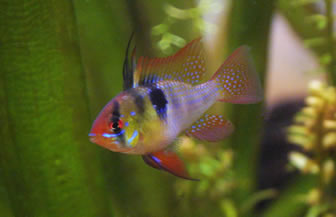
Juvenile German Blue Ram – 6 months old Picture by fishalicious
When you set up the aquarium, it is best to mimic the natural environment of the German blue ram. As mentioned above, wild rams are normally only found where there is plenty of covers consisting of aquatic plants or submerged land vegetation, and including such elements in the aquarium set up is therefore recommended. They should always be kept in a planted tank. The tank setup should contain densely grown groups of plants separated by open swimming space is ideal. The fish will also need a few caves to seek shelter in. If you want your fish to breed, provide them with flat stones in the aquarium.
German blue rams should in most cases not be kept in aquariums smaller than 75 L (20 gallons). Keeping two pairs together will require a 150 L (40 gallons) aquarium, and so on. The larger the aquarium size, the easier it will be to keep the water quality high enough. The German blue ram is sensitive to organic waste products such as nitrate and is therefore not a suitable choice unless you know how to keep the levels of organic waste down. An experienced aquarist that knows how to maintain good water quality in small aquariums can keep them in smaller aquariums. They can be bred in nano aquarium tanks.
Tankmates
Many aquarists believe that the German blue ram is really difficult to keep, but this is not really true. The problem is that many aquarists combine the ram with unsuitable species, such as aggressive fish that will harass the ram or overly energetic fish that will gulp down all the food before the ram gets a chance to eat. Other types of dwarf cichlids such as apistogramma cichlids are also an unsuitable choice. One exception from this rue is the Bolivian ram. You can keep Bolivian and German rams together in the same aquarium. Your German blue ram will do much better if you combine it will peaceful species that will leave some food for the rams. Keeping rams on their own is not recommended; they feel safer when combined with braver fish (so-called dither fish). Make sure that you use friendly dither fish such as cardinal tetras or neon tetras. Never keep tiger barbs as dither fish for rams.
You can keep your rams with moderately aggressive top dwelling fish such as pearl gouramis and dwarf gourami. Betta fish can sometimes be kept with german blue rams but that does not always work and I do not recommend that you try unless your aquarium is at least 150 L (40 gallons).
If your German blue rams become aggressive towards other fish in the aquarium, it is most likely caused by a shortage or suitable hiding places. It is also normal for them to become aggressive during breeding since they want to protect their offspring.
Caring for German Blue Rams
The German blue ram is not a suitable fish for newly set up aquariums; wait until the aquarium have been inhabited for quite a while and contains a thriving population of beneficial bacteria. You must also carry out frequent water changes and install adequate filtration. Wild German blue rams are typically found in areas with slow-flowing water, so vigorous water movements are not recommended in the aquarium.
Try to resemble the natural environment of the German blue ram in the aquarium, e.g. by using soft acidic water with a pH-value of 5. In the wild, the German blue ram is used to a water temperature of 25.5-29.5 ºC (78-85 ºF). Aquarium kept specimens will normally do fine up to 80 °F (27 °C) and they can usually adapt to a pH-value from 5.0 to 7.0. Some aquarists have even managed to keep German blue rams in moderately hard water. If you find it hard to keep the water in your aquarium acidic, add peat moss.
Feeding German Blue Ram
The German blue ram is an omnivore that needs food from both the animal kingdom and the plant kingdom to stay healthy and happy. When they arrive in a new aquarium, it is not unusual for them to lose their appetite and become really finicky. Don’t be surprised if your rams only nibble at the food or embark on a full-blown hunger strike. Try to coax them into eating by giving them really tasty morsels like frozen or live mosquito larvae or similar. Once they have started eating again, you can gradually let them try flake food, pellets and other types of food. After a while, most rams will readily accept a wide range of different foods in the aquarium.
Sexing German Blue Ram
The female fish is smaller than the male and have more pink pigmentation on her ventral region. If you look at the anterior region of the dorsal fin, you can see that her fin rays are less developed. It is also common for females to have a plumper body shape and more rounded edging of the tailfin. The back of the dorsal and anal fins have a more pointy edge in the male ram, and the tail fin is also more sharply edged. The male ram can be recognized on his V-shaped tail fin and the elongated second ray that is present in the dorsal fin.
These pictures will further help you sex you rams:
Male German Blue Ram
Picture by fishalicious
Female German Blue Ram
Picture by fishalicious
Breeding German Blue Ram
The German blue ram forms monogamous pairs and both parents engage in brood care. If you want a breeding pair to form you can purchase a group of juvenile fish and let them grow up together. They will then form their own pairs as they reach sexual maturity. German blue rams can reach sexual maturity at a fairly young age; sometimes the fish is no older than 4-6 months.
If you want to coax your rams into breeding, provide them with soft water and increase the water temperature a bit, up to 28 °C (82 °F). The recommended pH range is 5.5 – 6.5. Use a timer for the aquarium lights, because erratic day and night patterns can confuse them and interfere with normal breeding behavior. It is important to include flat stones in the aquarium set up. Some pairs prefer to dig small pits in the gravel and use as breeding sites instead or in combination with stones.
Don’t forget that German blue rams will become more aggressive than normally during the breeding period. Plenty of hiding spots and natural borders in the aquarium is recommended.
When its time for breeding, the red patch on the belly of the female will grow bigger and become much brighter than normally. A flat stone will be cleaned or a pit will be dug out by either of the fish. The couple will also start nudging each other and/or twirling, and the male fish can dart away at a high pace or slide against the body of the female.
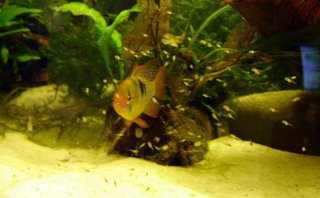
German blue ram with one-week-old fry Picture by fishalicious
During spawning, the female will place small adhesive eggs on the flat stones or in the small pits. The eggs are 0.9-1.5 mm in length (0.035-0.059 inches). A typical batch will consist of 150-300 eggs, but some batches contain no more than 20 eggs while others contain over 500 eggs.
Both the male and the female fish should be allowed to stay with the offspring because this species practice biparental brood care and the parents work together to care for the eggs and guard the territory. A parent will fan fresh water over the eggs to prevent attacks from fungi and bacteria. The parents will also eat unfertile eggs to prevent them from turning into breeding grounds for pathogens.
The eggs will usually hatch within 40 hours if the water is kept in the upper part of the recommended temperature range. The eggs average hatching time is about 35 hours. It will then take roughly 5 days before the offspring become free swimming. The free swimming fry will be kept in a dense school and be cared for by the parents. They will be escorted by their mother or father during foraging.
Don’t lose heart if the first few spawnings are unsuccessful. A lot of things can go wrong and it is common for German blue rams to spawn a few times before they get everything right. They might, for instance, eat a few batches before they become good parents. Once they have started breeding, you can, however, expect a new batch once a month or so. Young pairs are known to fight quite a lot and the aquarium must contain plenty of hiding spots to avoid stress and injury.
If your couple continues to eat their offspring even after several spawnings it can be a sight of distress in the aquarium. Try to figure out what stresses your fish and do your best to make the aquarium more relaxing for them.
Fry Development
The below pictures illustrates how the fry develop and how they look at different ages:
Fry 1 week old:
Fry 2 weeks old:
Fry 1 month old:
Fry 1,5 month old:
Fry 2 months old:
Fry 2,5 months old:
Fry 3 months old:
Fry 6 months old:
All fry pictures by fishalicious
German blue rams for sale
Finding the germans blue ram cichlid for sale is seldom very hard. You can usually find them at your local Petsmart as well as in most local fish stores. I do not recommend buying your germans blue rams from Petsmart. They usually sell them for a low price and often have a variety of different types including longfin rams but the rams for sale at Petsmart and other chain stores are usually low-quality fish that has been mass produced in Asia. The Asian bred German blue rams for sale in many chain stores are a lot more sensitive and prone to disease. Many fish die during the first week after having been purchased. Quality locally bred fish is a lot more hardy. The fact that many stores sell low-quality rams is one important that many fish keepers think that rams are hard to keep. Not all fish bred in Asia is low quality but the ram is one fish where you should try to buy locally produced fish.
Most stores keep male and female German blue rams for sale together in the same aquarium. It can hard to tell the sexes apart if you are buying young fish but you should be able to do so following the sexing guide earlier in this article.
The best way to buy Rams is to visit craigslist or do a google search for “German blue rams for sale near me” in Google. This allows you to find a good local breeder from whom you can buy the fish. You can also visit a site like tropicalfichauctions.com or Aquabid and buy your fish from there. Most fish sold in these auctions are sold by dedicated breeders who love their fish.
These websites are also the best place to find electric blue rams, dark knight, balloon, longfin and other types of German blue rams for sale.
Our knowledgeable staff usually responds to any question within 24 hours
